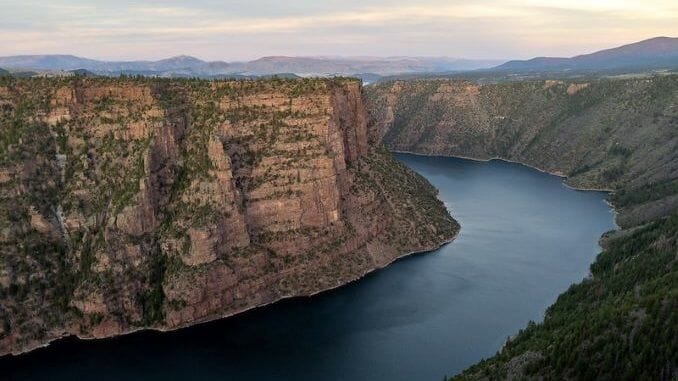5 Ways The Trendy Flaming Gorge Reservoir Rivals Lake Powell
Photo cby Matthew Dillon, shared via Flickr Travel Lists flaming gorge
“Get Out There” is a new column for itchy footed humans written by Paste contributor Blake Snow. Although weird now, travel is still worthwhile—especially to these open borders.
The first time I visited Flaming Gorge, I had no intention of boating it. After traveling through nearby Dinosaur National Monument, my family drove two hours north to Red Canyon Overlook to hike the rim and take in the 1400 foot cliffs.
Then we saw a handful of ski boats far below, enjoying “glass” conditions on the giant lake, in the middle of the afternoon. “We have to come back to boat this,” I said to my wife.
This summer we did. After years of enjoying Lake Powell on the opposite end of Utah, we now have a new favorite spot that’s a lot more “socially distant” but just as fun as the more popular Powell. Here’s why:
1. Big canyons, clear water, can’t lose.
Like Lake Powell, Flaming Gorge is home to towering red cliffs and playful water. Only as you can see from the included photo, the latter’s cliffs are peppered with beautiful green pines. Not only are these cool to look at, but they provide much needed shade during the summer months, something the former can’t compete with. Which brings me to my next point…
2. Boat camping is a must.
On the much more scenic and recreational-friendly Utah side of Flaming Gorge (the rest is found in Wyoming), you’ll find two major marinas and over a half dozen designated campgrounds. The more remote ones include the secluded Kingfisher Island and Jarvis Canyon, which will get you far away from the gathering crowds at other campgrounds. You’ll need a boat to get to these and others, but that translates into even more solitude.
3. Wake surfing, cliff-jumping, and more.
Over the course of five days, my family enjoyed wake surfing, fishing, swimming, tubing, and cliff jumping right from our campground. Rafting, hiking, and mountain biking are also available. Save for a single afternoon (due to wind), the water never got choppy, allowing us to boat for extended periods of time. As part of a National Dark Sky Area, the stargazing is also superb. While craning necks above campfires, we saw long-streaking shooting stars and the Milky Way every night.
4. More bearable temperatures and open space.
“Flaming Gorge is the kind of place you’d think would be overrun, but it’s not,” one official recently told me. Although visitors are two to three times more than they were a few years ago, it’s nowhere near the overcrowded levels that Lake Powell often endures. On top of that, thanks to its 6000 foot elevation, Flaming Gorge’s highs rarely exceed the 80s, and the water never gets bathwater warm like Powell in the summer, which robs the lake of its refreshing nature.
5. Times change.
Early American explorer John Wesley Powell played a significant role in the modern discovery of Flaming Gorge and his namesake Lake Powell. The guy was drawn to natural beauty. If I’m really being honest with myself, you should experience both lakes at least once during your travels of the great American West by powerboat. But as outdoor crowds dramatically increase in a post-pandemic world, Flaming Gorge is a lot more compelling and nearly as beautiful as the houseboat capital of the world.
Blake Snow contributes to fancy publications and Fortune 500 companies as a bodacious writer-for-hire and frequent travel columnist. He lives in Provo, Utah with an adolescent family and their “bullador beagle.”